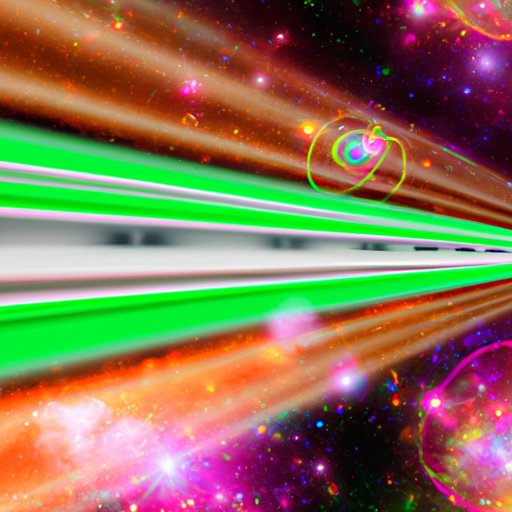Introduction
Light years are a measure of distance in space, equal to the distance that light travels in one year, which is roughly 6 trillion miles. This means that 4.2 light years is an incredibly long distance to travel, and it represents a major milestone for space exploration. But just how long would it take to get to such a distant destination? In this article, we will explore the various possibilities for making a journey of this magnitude.
Calculating the Time Needed to Reach 4.2 Light Years Away
The speed of light is the maximum speed at which all energy, matter, and information can travel in the universe, and it is a fundamental constant of nature. It is impossible to travel faster than the speed of light, so any journey across interstellar space will necessarily take a significant amount of time. The exact time needed depends on several factors, including the distance traveled, the effects of time dilation, and the propulsion system used.
Time dilation is a phenomenon that occurs when a body moves at relativistic speeds. As a result, time passes more slowly for the moving object than it does for a stationary observer. This means that the closer an object gets to the speed of light, the slower time passes for that object, allowing greater distances to be covered in a shorter amount of time.
The distance traveled is also important in determining the time needed for a journey. 4.2 light years is equivalent to roughly 25 trillion miles, so any journey of this magnitude would require a tremendous amount of time to complete. Even if a spacecraft were able to travel at the speed of light, it would still take 4.2 years to reach its destination.

Exploring the Possibilities of Traveling 4.2 Light Years
There are currently a number of potential propulsion systems that could be used to make such a journey. Conventional rocket propulsion systems, such as chemical rockets or ion engines, are limited by the amount of fuel they can carry, and thus would take an incredibly long time to reach a destination 4.2 light years away. More advanced systems, such as nuclear fusion or antimatter engines, have the potential to increase the speed of a spacecraft, but they are still in the early stages of development.
Theoretically, it is possible to travel much faster than the speed of light using warp drive technology. This would involve manipulating space-time to create a “warp bubble” that would move the spacecraft faster than light. However, this technology is currently only theoretical, and it is not known if it is even possible to create such a warp bubble.
What Would it Take to Reach 4.2 Light Years Away?
In addition to the technological limitations of reaching 4.2 light years away, there are other considerations, such as the availability of resources and the cost of the journey. A spacecraft would need to carry enough fuel, food, and other supplies to last the entire duration of the journey, which could be prohibitively expensive. Furthermore, the cost of launching such a spacecraft could be astronomical, as it would require a powerful rocket and a lot of fuel.
How Long Does it Take to Travel 4.2 Light Years?
Estimating the exact time needed to travel 4.2 light years is difficult, as there are many unknowns, such as the type of propulsion system used and the effects of time dilation. However, it is possible to make some educated guesses based on current technologies. For example, if a spacecraft were to travel at the speed of light, it would take 4.2 years to reach its destination. If a more advanced propulsion system were used, such as a nuclear fusion engine, it is possible that the journey could be completed in a fraction of the time, depending on the efficiency of the engine.
It is also worth noting that a journey of this magnitude is significantly longer than other interplanetary journeys that have been undertaken. For example, it took the New Horizons spacecraft 9.5 years to reach Pluto, which is roughly 3.7 billion miles away, while a journey to 4.2 light years would take more than 1,000 times as long.

Unlocking the Mysteries of a 4.2 Light Year Journey
Making a journey of this magnitude would open up a world of possibilities for exploration and discovery. Navigating interstellar space would be a complex task, requiring advanced navigation systems and sensors to detect objects in the far reaches of space. Additionally, the spacecraft would need to be equipped with powerful telescopes to observe distant stars and galaxies.
The journey would also provide an opportunity to discover new worlds. As the spacecraft travels through space, it could search for planets and moons that could potentially be habitable. Such discoveries could revolutionize our understanding of the universe and provide invaluable insight into the origins and evolution of life.
Conclusion
Traveling 4.2 light years is an incredible feat that would require a tremendous amount of time and resources. While it is theoretically possible to make such a journey, the exact time needed is difficult to estimate due to the many unknowns involved. Nevertheless, the potential rewards of such an endeavor are immense, as it would unlock the mysteries of the universe and provide unparalleled opportunities for exploration and discovery.
(Note: Is this article not meeting your expectations? Do you have knowledge or insights to share? Unlock new opportunities and expand your reach by joining our authors team. Click Registration to join us and share your expertise with our readers.)
